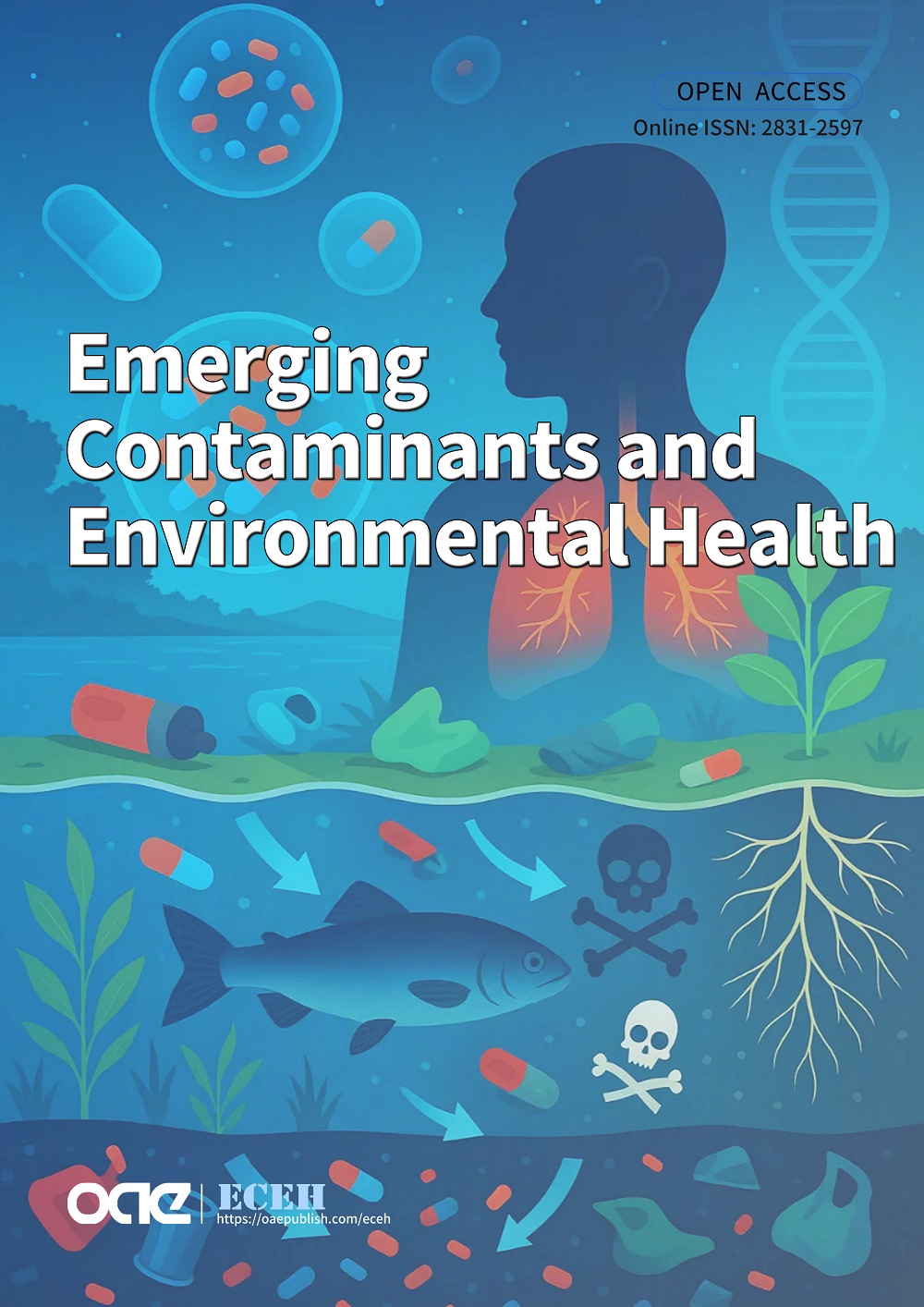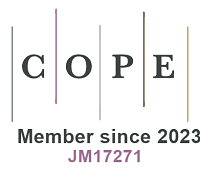REFERENCES
1. Ritchie, H.; Samborska, V.; Roser, M. Plastic pollution. https://ourworldindata.org/plastic-pollution. (accessed 5 Sep 2025).
2. Rieger, N.; Olmedo, E.; Thiel, M.; et al. Seasonal hotspots of beach litter in the North-East Atlantic linked to aquaculture and river runoff. Commun. Earth. Environ. 2024, 5, 1913.
3. Ostle, C.; Thompson, R. C.; Broughton, D.; Gregory, L.; Wootton, M.; Johns, D. G. The rise in ocean plastics evidenced from a 60-year time series. Nat. Commun. 2019, 10, 1622.
4. Kaandorp, M. L. A.; Lobelle, D.; Kehl, C.; Dijkstra, H. A.; van Sebille, E. Global mass of buoyant marine plastics dominated by large long-lived debris. Nat. Geosci. 2023, 16, 689-94.
5. Prata, J. C. A One Health perspective on water contaminants. Water. Emerg. Contam. Nanoplastics. 2022, 1, 15.
6. Jin, X.; Li, Z.; Peñuelas, J.; et al. Quantitative assessment on the distribution patterns of microplastics in global inland waters. Commun. Earth. Environ. 2025, 6, 2320.
7. Galgani, F.; Brien, A. S.; Weis, J.; et al. Are litter, plastic and microplastic quantities increasing in the ocean? Micropl. Nanopl. 2021, 1, 2.
8. Gerigny, O.; Blanco, G.; Lips, U.; et al. Comparative analysis of microplastics detection methods applied to marine sediments: a case study in the Bay of Marseille. Mar. Pollut. Bull. 2024, 207, 116787.
9. Topouzelis, K.; Papageorgiou, D.; Karagaitanakis, A.; Papakonstantinou, A.; Arias Ballesteros, M. Remote sensing of sea surface artificial floating plastic targets with Sentinel-2 and Unmanned Aerial Systems (Plastic Litter Project 2019). Remote. Sens. 2020, 12, 2013.
10. Papageorgiou, D.; Topouzelis, K.; Suaria, G.; Aliani, S.; Corradi, P. Sentinel-2 detection of floating marine litter targets with partial spectral unmixing and spectral comparison with other floating materials (Plastic Litter Project 2021). Remote. Sens. 2022, 14, 5997.
11. Themistocleous, K.; Papoutsa, C.; Michaelides, S.; Hadjimitsis, D. Investigating detection of floating plastic litter from space using Sentinel-2 imagery. Remote. Sens. 2020, 12, 2648.
12. Ciappa, A. C. Marine plastic litter detection offshore Hawai’i by Sentinel-2. Mar. Pollut. Bull. 2021, 168, 112457.
13. Zhu, X.; Lu, Y.; Dou, C.; Ju, W. Improving sea surface floating matter identification from Sentinel-2 MSI imagery using optical radiative simulation of neighborhood difference. Opt. Express. 2023, 31, 27612-20.
14. Biermann, L.; Clewley, D.; Martinez-Vicente, V.; Topouzelis, K. Finding plastic patches in coastal waters using optical satellite data. Sci. Rep. 2020, 10, 5364.
15. Biermann, L.; Clewley, D.; Martinez-Vicente, V.; Topouzelis, K. Detecting and identifying floating plastic debris in coastal waters using Sentinel-2 Earth observation data. In EGU General Assembly 2020. 2020; Paper EGU2020-19145.
16. Wu, C.; Chen, Z.; An, C. A novel spectral index for detecting large plastic accumulations using Sentinel-2 imagery. SSRN 2025.
17. Valente, A.; Castanho, E.; Giusti, A.; Pinelo, J.; Silva, P. An open-source data pipeline framework to detect floating marine plastic litter using Sentinel-2 imagery and machine learning. In IGARSS 2023 - 2023 IEEE International Geoscience and Remote Sensing Symposium, Pasadena, USA. Jul 16-21, 2023. IEEE; 2023. pp. 4108-11.
18. Jayabhavani, G. N.; Muthu, T. Floating litter detection at the estuary of Puducherry using Sentinel-2 data and machine learning model. Reg. Stud. Mar. Sci. 2024, 77, 103686.
19. Sannigrahi, S.; Basu, B.; Basu, A. S.; Pilla, F. Development of automated marine floating plastic detection system using Sentinel-2 imagery and machine learning models. Mar. Pollut. Bull. 2022, 178, 113527.
20. Basu, B.; Sannigrahi, S.; Sarkar Basu, A.; Pilla, F. Development of novel classification algorithms for detection of floating plastic debris in coastal waterbodies using multispectral Sentinel-2 remote sensing imagery. Remote. Sens. 2021, 13, 1598.
21. Booth, H.; Ma, W.; Karakuş, O. High-precision density mapping of marine debris and floating plastics via satellite imagery. Sci. Rep. 2023, 13, 6822.
22. Jamali, A.; Mahdianpari, M. A cloud-based framework for large-scale monitoring of ocean plastics using multi-spectral satellite imagery and generative adversarial network. Water 2021, 13, 2553.
23. Priyadarshini, R.; Varun, A.; Sowmya, K. S. Automated marine debris detection from Sentinel-2 satellite imagery. In 2024 IEEE Space, Aerospace and Defence Conference (SPACE), Bangalore, India. Jul 22-23, 2024. IEEE; 2024. pp. 454-8.
24. Mohsen, A.; Kiss, T.; Kovács, F. Machine learning-based detection and mapping of riverine litter utilizing Sentinel-2 imagery. Environ. Sci. Pollut. Res. Int. 2023, 30, 67742-57.
25. Acuña-Ruz, T.; Uribe, D.; Taylor, R.; et al. Anthropogenic marine debris over beaches: spectral characterization for remote sensing applications. Remote. Sens. Environ. 2018, 217, 309-22.
26. Zhou, S.; Kuester, T.; Bochow, M.; Bohn, N.; Brell, M.; Kaufmann, H. A knowledge-based, validated classifier for the identification of aliphatic and aromatic plastics by Worldview-3 satellite data. Remote. Sens. Environ. 2021, 264, 112598.
27. Tasseron, P.; van Emmerik, T.; Peller, J.; Schreyers, L.; Biermann, L. Advancing floating macroplastic detection from space using hyperspectral imagery. Remote. Sens. 2021, 13, 2335.
28. Biermann, L.; Schreyers, L.; van Emmerik, T.; Bui, T. K.; Ling, Y.; Streett, D. Finding riverine plastics in floating plant patches using Worldview-3 satellite imagery. In EGU General Assembly 2022. 2022; Paper EGU22-12856.
29. Jakovljević, G.; Govedarica, M.; Taboada, FÁ. Remote sensing data in mapping plastics at surface water bodies. In FIG Working Week, Hanoi, Vietnam. Apr 22-26, 2019. https://www.fig.net/resources/proceedings/fig_proceedings/fig2019/papers/ts01d/TS01D_jakovljevic_govedarica_et_al_9974.pdf. (accessed 5 Sep 2025).
30. Garaba, S. P.; Harmel, T. Top-of-atmosphere hyper and multispectral signatures of submerged plastic litter with changing water clarity and depth. Opt. Express. 2022, 30, 16553-71.
31. Park, Y. J.; Garaba, S. P.; Sainte-Rose, B. Detecting the Great Pacific Garbage Patch floating plastic litter using WorldView-3 satellite imagery. Opt. Express. 2021, 29, 35288-98.
32. Kikaki, A.; Karantzalos, K.; Power, C. A.; Raitsos, D. E. Remotely sensing the source and transport of marine plastic debris in Bay Islands of Honduras (Caribbean Sea). Remote. Sens. 2020, 12, 1727.
33. Atwood, E. C.; Falcieri, F. M.; Piehl, S.; et al. Coastal accumulation of microplastic particles emitted from the Po River, Northern Italy: comparing remote sensing and hydrodynamic modelling with in situ sample collections. Mar. Pollut. Bull. 2019, 138, 561-74.
34. Taggio, N.; Aiello, A.; Ceriola, G.; et al. A combination of machine learning algorithms for marine plastic litter detection exploiting hyperspectral PRISMA data. Remote. Sens. 2022, 14, 3606.
35. Kremezi, M.; Kristollari, V.; Karathanassi, V.; et al. Pansharpening PRISMA data for marine plastic litter detection using plastic indexes. IEEE. Access. 2021, 9, 61955-71.
36. Salgado-Hernanz, P. M.; Bauzà, J.; Alomar, C.; Compa, M.; Romero, L.; Deudero, S. Assessment of marine litter through remote sensing: recent approaches and future goals. Mar. Pollut. Bull. 2021, 168, 112347.
37. Mukonza, S. S.; Chiang, J. Satellite sensors as an emerging technique for monitoring macro- and microplastics in aquatic ecosystems. Water. Emerg. Contam. Nanoplastics. 2022, 1, 17.
38. Park, S.; Kim, C.; Jeong, S.; et al. Review of remote sensing applicability for monitoring marine microplastics. Korean. J. Remote. Sens. 2022, 38, 835-50.
39. Veettil, B. K.; Hong Quan, N.; Hauser, L. T.; Doan Van, D.; Quang, N. X. Coastal and marine plastic litter monitoring using remote sensing: a review. Estuar. Coast. Shelf. Sci. 2022, 279, 108160.
40. Ma, J.; Ma, R.; Pan, Q.; Liang, X.; Wang, J.; Ni, X. A global review of progress in remote sensing and monitoring of marine pollution. Water 2023, 15, 3491.
41. Goddijn-Murphy, L.; Martínez-Vicente, V.; Dierssen, H. M.; et al. Emerging technologies for remote sensing of floating and submerged plastic litter. Remote. Sens. 2024, 16, 1770.
42. Chabot, D.; Marteinson, S. C. Aerial remote sensing of aquatic microplastic pollution: the state of the science and how to move it forward. Microplastics 2024, 3, 685-95.
43. Dierssen, H. M.; Gierach, M.; Guild, L. S.; et al. Synergies between NASA’s hyperspectral aquatic missions PACE, GLIMR, and SBG: opportunities for new science and applications. J. Geophys. Res. Biogeosci. 2023, 128, e2023JG007574.
44. Frouin, R.; Tan, J. PCA-based atmospheric correction of PACE OCI ocean color imagery. In Active and Passive Remote Sensing of Oceans, Seas, and Lakes. 2025.
45. Vandermeulen, R.; Lance, V.; Otoshi, C.; Riley, K.; Tomlinson, M.; Trinh, R. Plankton, Aerosol, Cloud and ocean Ecosystem (PACE) satellite data for aquaculture and fisheries management. 2025.
46. Frouin, R. J.; Franz, B. A.; Ibrahim, A.; et al. Atmospheric correction of satellite ocean-color imagery during the PACE Era. Front. Earth. Sci. 2019, 7, 145.
47. Jutla, A. S.; Akanda, A. S.; Islam, S. A framework for predicting endemic cholera using satellite derived environmental determinants. Environ. Model. Softw. 2013, 47, 148-58.
48. Engstrom, R.; Hersh, J.; Newhouse, D. Poverty from space: using high resolution satellite imagery for estimating economic well-being. World. Bank. Econ. Rev. 2022, 36, 382-412.
49. Wu, Z.; Zhang, C.; Gu, X.; et al. Deep learning enables satellite-based monitoring of large populations of terrestrial mammals across heterogeneous landscape. Nat. Commun. 2023, 14, 3072.
50. Raynor, J.; Orofino, S.; Costello, C.; McDonald, G.; Mayorga, J.; Sala, E. Little-to-no industrial fishing occurs in fully and highly protected marine areas. Science 2025, 389, 392-5.
51. NASA Applied Remote Sensing Training Program (ARSET). ARSET - Introduction to Plankton, Aerosol, Cloud, Ocean Ecosystem (PACE) hyperspectral observations for water quality monitoring. 2024. https://appliedsciences.nasa.gov/get-involved/training/english/arset-introduction-plankton-aerosol-cloud-ocean-ecosystem-pace. (accessed 5 Sep 2025).
52. Meister, G.; Knuble, J. J.; Bars,
53. Meister, G.; Knuble, J. J.; Gliese, U.; et al. The Ocean Color Instrument (OCI) on the Plankton, Aerosol, Cloud, ocean Ecosystem (PACE) Mission: system design and prelaunch radiometric performance. IEEE. Trans. Geosci. Remote. Sens. 2024, 62, 1-18.
54. Gliese, U.; Rhodes, Z.; Squire, K.; et al. Pulse response of the short-wave infrared detection system of the ocean color instrument for the NASA PACE mission. In Sensors, Systems, and Next-Generation Satellites XXVII. 2023.
55. Lee, S.; Meister, G.; Kitchen, S.; Knuble, J.; Gliese, U.; Bousquet, R. PACE OCI crosstalk characterization based on pre-launch testing. In Sensors, Systems, and Next-Generation Satellites XXVII. 2023.
56. Zibordi, G.; Talone, M.; Voss, K. J.; Johnson, B. C. Impact of spectral resolution of in situ ocean color radiometric data in satellite matchups analyses. Opt. Express. 2017, 25, A798-812.
57. Olyaei, M.; Ebtehaj, A. Uncovering plastic litter spectral signatures: a comparative study of hyperspectral band selection algorithms. Remote. Sens. 2024, 16, 172.
58. Singh, M. K.; Hait, S.; Thakur, A. Hyperspectral imaging-based classification of post-consumer thermoplastics for plastics recycling using artificial neural network. Process. Saf. Environ. Prot. 2023, 179, 593-602.
59. Hasekamp, O. P.; Fu, G.; Rusli, S. P.; et al. Aerosol measurements by SPEXone on the NASA PACE mission: expected retrieval capabilities. J. Quant. Spectrosc. Radiat. Transfer. 2019, 227, 170-84.
60. Rietjens, J.; Campo, J.; Chanumolu, A.; et al. Expected performance and error analysis for SPEXone, a multi-angle channeled spectropolarimeter for the NASA PACE mission. In Polarization Science and Remote Sensing IX. 2019.
61. Smit, J. M.; Rietjens, J. H. H.; van Harten, G.; et al. SPEX airborne spectropolarimeter calibration and performance. Appl. Opt. 2019, 58, 5695-719.
62. Ottaviani, M.; Cairns, B.; Chowdhary, J.; et al. Polarimetric retrievals of surface and cirrus clouds properties in the region affected by the Deepwater Horizon oil spill. Remote. Sens. Environ. 2012, 121, 389-403.
63. Ottaviani, M.; Chowdhary, J.; Cairns, B. Remote sensing of the ocean surface refractive index via short-wave infrared polarimetry. Remote. Sens. Environ. 2019, 221, 14-23.
64. Jamet, C.; Ibrahim, A.; Ahmad, Z.; et al. Going beyond standard ocean color observations: lidar and polarimetry. Front. Mar. Sci. 2019, 6, 251.
65. Arksey, H.; O’malley, L. Scoping studies: towards a methodological framework. Int. J. Soc. Res. Methodol. 2005, 8, 19-32.
66. Paré, G.; Kitsiou, S. Chapter 9 Methods for literature reviews. In: Lau F, Kuziemsky C, Editors. Handbook of eHealth evaluation: an evidence-based approach. University of Victoria; 2017. https://www.ncbi.nlm.nih.gov/books/NBK481583/. (accessed 5 Sep 2025).
67. GIZ. Advances in remote sensing of plastic waste. 2023. https://globalplasticshub.org/technical-resource/10838. (accessed 5 Sep 2025).
68. Maximenko, N.; Corradi, P.; Law, K. L.; et al. Toward the integrated marine debris observing system. Front. Mar. Sci. 2019, 6, 447.
69. Vasudeva, M.; Warrier, A. K.; Kartha, V.; Unnikrishnan, V. Advances in microplastic characterization: spectroscopic techniques and heavy metal adsorption insights. TrAC. Trends. Anal. Chem. 2025, 183, 118111.
70. Wang, J.; Kim, K.; Ofiara, D.; et al. Chapter 25 - Marine debris. In The first global integrated marine assessment: World Ocean Assessment I. Cambridge University Press; 2017. pp. 389-408.
71. Bermúdez, J. R.; Swarzenski, P. W. A microplastic size classification scheme aligned with universal plankton survey methods. MethodsX 2021, 8, 101516.
72. Egger, M.; Schilt, B.; Wolter, H.; et al. Pelagic distribution of plastic debris (> 500 µm) and marine organisms in the upper layer of the North Atlantic Ocean. Sci. Rep. 2022, 12, 13465.
73. Garaba, S. P.; Dierssen, H. M. An airborne remote sensing case study of synthetic hydrocarbon detection using short wave infrared absorption features identified from marine-harvested macro- and microplastics. Remote. Sens. Environ. 2018, 205, 224-35.
74. Castagna, A.; Dierssen, H. M.; Devriese, L. I.; Everaert, G.; Knaeps, E.; Sterckx, S. Evaluation of historic and new detection algorithms for different types of plastics over land and water from hyperspectral data and imagery. Remote. Sens. Environ. 2023, 298, 113834.
75. International Ocean-Colour Coordinating Group (IOCCG). IOCCG Task Force: remote sensing of marine litter and debris. https://ioccg.org/group/marine-litter-debris/. (accessed 5 Sep 2025).
76. European Space Agency (ESA). TPM data help advance plastic litter detection from space. 2023. https://earth.esa.int/eogateway/news/tpm-data-help-advance-plastic-litter-detection-from-space. (accessed 5 Sep 2025).
77. Guffogg, J.; Soto-Berelov, M.; Bellman, C.; Jones, S.; Skidmore, A. Beached plastic debris index; a modern index for detecting plastics on beaches. Mar. Pollut. Bull. 2024, 209, 117124.
78. de Fockert, A.; Eleveld, M. A.; Bakker, W.; et al. Assessing the detection of floating plastic litter with advanced remote sensing technologies in a hydrodynamic test facility. Sci. Rep. 2024, 14, 25902.
79. ESA. Characterization of light polarization properties of virgin and marine-harvested plastic litter toward remote-sensing mapping of ocean plastics. Ocean Plastics Polarization Properties OP3. 2022. https://nebula.esa.int/sites/default/files/neb_study/2676/OP3_400013203720_Executive_Summary_16Dec2022_v2_0.pdf. (accessed 5 Sep 2025).
80. Cózar, A.; Arias, M.; Suaria, G.; et al. Proof of concept for a new sensor to monitor marine litter from space. Nat. Commun. 2024, 15, 4637.
81. Moshtaghi, M.; Knaeps, E.; Sterckx, S.; Garaba, S.; Meire, D. Spectral reflectance of marine macroplastics in the VNIR and SWIR measured in a controlled environment. Sci. Rep. 2021, 11, 5436.
82. Ho, D.; Prabhakar, P.; Karthikeyan, K. G.; Feng, H. Shedding light on the polymer’s identity: microplastic detection and identification through Nile Red staining and multispectral imaging (FIMAP). J. Environ. Chem. Eng. 2025, 13, 117944.
83. Mahmoud, A.; El-Sharkawy, Y. H. Instant plastic waste detection on shores using laser-induced fluorescence and associated hyperspectral imaging. Opt. Quant. Electron. 2024, 56, 6564.
84. Remer, L. A.; Knobelspiesse, K.; Zhai, P.; et al. Retrieving aerosol characteristics from the PACE mission, Part 2: multi-angle and polarimetry. Front. Environ. Sci. 2019, 7, 94.
85. Fronkova, L.; Brayne, R. P.; Ribeiro, J. W.; Cliffen, M.; Beccari, F.; Arnott, J. H. W. Assessing the effect of water on submerged and floating plastic detection using remote sensing and K-means clustering. Remote. Sens. 2024, 16, 4405.
86. Cetinić, I.; Rousseaux, C. S.; Carroll, I. T.; et al. Phytoplankton composition from sPACE: requirements, opportunities, and challenges. Remote. Sens. Environ. 2024, 302, 113964.
87. Schollaert Uz, S.; Kim, G. E.; Mannino, A.; Werdell, P. J.; Tzortziou, M. Developing a community of practice for applied uses of future PACE data to address marine food security challenges. Front. Earth. Sci. 2019, 7, 283.
88. Sellaperumal, P.; Kaliaperumal, R.; Dhanaraju, M.; et al. Time series analysis of Sentinel 1 A SAR data to retrieve annual rice area maps and long-term dynamics of start of season. Sci. Rep. 2025, 15, 8202.
89. Hu, C. Remote detection of marine debris using satellite observations in the visible and near infrared spectral range: challenges and potentials. Remote. Sens. Environ. 2021, 259, 112414.
90. Du, Q.; Chang, C. Linear mixture analysis-based compression for hyperspectral image analysis. IEEE. Trans. Geosci. Remote. Sens. 2004, 42, 875-91.
91. Wang, L.; Bi, Y.; Wang, W.; Li, J. Endmember extraction and abundance estimation algorithm based on double-compressed sampling. Sci. Rep. 2024, 14, 17934.
92. Zuo, C.; Qian, J.; Feng, S.; et al. Deep learning in optical metrology: a review. Light. Sci. Appl. 2022, 11, 39.
93. Jones, D. O. B.; Gates, A. R.; Huvenne, V. A. I.; Phillips, A. B.; Bett, B. J. Autonomous marine environmental monitoring: application in decommissioned oil fields. Sci. Total. Environ. 2019, 668, 835-53.
94. Lou, J.; Liu, B.; Xiong, Y.; Zhang, X.; Yuan, X. Variational autoencoder framework for hyperspectral retrievals (Hyper-VAE) of phytoplankton absorption and chlorophyll a in coastal waters for NASA’s EMIT and PACE missions. IEEE. Trans. Geosci. Remote. Sens. 2025, 63, 1-16.
95. Isachenko, I.; Chubarenko, I. Transport and accumulation of plastic particles on the varying sediment bed cover: open-channel flow experiment. Mar. Pollut. Bull. 2022, 183, 114079.
96. Parashar, N.; Mahanty, B.; Hait, S. Microplastics as carriers of per- and polyfluoroalkyl substances (PFAS) in aquatic environment: interactions and ecotoxicological effects. Water. Emerg. Contam. Nanoplastics. 2023, 3, 15.
97. Mukonza, S. S.; Chaukura, N. Bird’s-eye view of per- and polyfluoroalkyl substances pollution research in the African hydrosphere. npj. Clean. Water. 2025, 8, 495.
98. Martinez-Vicente, V. The need for a dedicated marine plastic litter satellite mission. Nat. Rev. Earth. Environ. 2022, 3, 728-9.
99. Martínez-Vicente, V.; Clark, J. R.; Corradi, P.; et al. Measuring marine plastic debris from space: initial assessment of observation requirements. Remote. Sens. 2019, 11, 2443.







